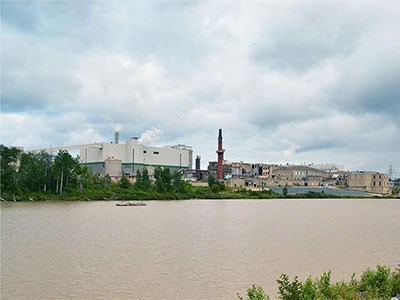Iroquois Falls Mayor Michael Shea remembers his first meeting with Justus Veldman in the Porter Airways lounge in Toronto on Dec. 22, 2014.
It was the same day the last roll of newsprint was coming off the No. 8 paper machine at Resolute’s soon-to-be-shuttered mill in the northeastern Ontario town of 4,500.
Earlier that month, the Quebec forest products giant had decided to permanently pull the plug on the mill, putting 180 out of work.
Prior to a meeting with Resolute’s corporate heads in Montreal, Shea extended a cold-call invitation to Veldman to ask if he was interested in joining him, which the Sault Ste. Marie-based brownfield redeveloper enthusiastically accepted.
“Since that day, we’ve had a good relationship,” said Shea in finding a kindred spirit. “I think he’s like a brother somehow.”
Shea was well aware of Veldman’s growing body of work in Northern Ontario, beginning with the demolition the former St. Marys Paper mill site in the Sault, and preservation of its century-old sandstone administrative buildings and machine shops into vibrant community gathering places.
A year’s worth of confidential negotiations that followed between the two companies finally culminated with a Jan. 19 announcement before a packed house at the Iroquois Falls Community Centre that the mill and more than 300 acres of Resolute property in and around the town were being transferred to Riversedge and the municipality in an asset sale agreement.
The ebullient mayor was painting the transaction as a “dawn of a new day in Iroquois Falls.”
Veldman said his company, operating under the project banner of Abitibi Riversedge, picks up 115 acres, including the mill and a trestle bridge built during the Abitibi Paper Company days to haul wood into town.
Exact details of the sale remain unclear and it’s unclear how much acreage the Town of Iroquois Falls will inherit. Officials at Resolute Forest Products were not immediately available for comment.
Shea said the municipality acquires several acres of wooded and cleared land, some on the banks of the Abitibi River, along with an historic company guest house.
In reaching out to Veldman, Shea was drawn by his expansive thinking on what the region can become.
“I think he, much like myself, has a vision for what Northern Ontario is going to look like. It may not happen tomorrow or the year after, but one has to be assured that Sault Ste. Marie, Iroquois Falls and all these small towns aren’t going to disappear any time soon.”
Veldman’s award-winning company is taking on other restorative projects with the demolished Northern Breweries site in the Sault’s downtown, plans to create a mixed-use Canal District development along the city’s waterfront, and finding a new industrial use for the former Norampac mill in Red Rock.
To exclusively manage the Iroquois Falls project, Riversedge inked a partnership agreement with MHPM, one of Canada’s largest project management firms.
“It’s a big step for us as a company, and much needed.”
For the mill site remediation, Veldman said tenders are being written — and will be awarded in early February — for asbestos abatement, soil remediation, and demolition, starting this spring.
He estimates there’s probably a “good two years” of cleanup work to make it shovel-ready, while he consults with the community to brainstorm for ideas to readapt the site for a next generation of business opportunities.
“The local people have the best knowledge of what could happen there.”
As a 100-year-old heavy industrial site with rail access, there’s potential to reshape it into a commercial-industrial park, or, Veldman suggests, possibly a greenhouse complex, using inexpensive steam heat generated by Northland Power.
“I have a passion for local food and I wonder out loud, could we grow food for the Far North?”
Given the state of many small Northern towns, Veldman said new-era thinking is needed to better utilize the natural resources and revitalize the economy.
“I think that if we can get sites like this ready for the reindustrialization of the North — which is going to happen — the industry and the economics at one point are going to make it work to again harvest the largest fibre basket in the North.”
But before all the mill buildings dissolve into dust, Veldman has his eyes on preserving a three-storey train shed built in 1914, an architecturally significant structure seldom seen by many in the community.
Also high on his agenda is addressing the 90-year-old trestle bridge which was closed by Resolute due to unsafe structural conditions, forcing angry cottagers and outdoor enthusiasts to re-route their travels through Cochrane.
“Those small businesses in Iroquois Falls missed out on a lot of (cottage) activity because of the closure of that bridge,” said Veldman, who intends to roll out a repair plan in conjunction with a local working group.
Shea senses great relief in town now that the mill site ownership has changed hands and a course of action has been set.
Many in this largely retirement town had mentally turned the page on those jobs returning, but were also nervous and inquisitive about the eerie silence surrounding the site’s future.
Shea said it was tough to keep a lid on the highly sensitive negotiations over several months, but there were no signs of a panicky mass exodus from the community.
“People are moving here as opposed to moving out. We’re not feeling outmigration as we speak and this has been over a year (since the closure announcement).”
About 13 or 14 homes have been sold to new arrivals that commute to jobs in Timmins, a 35-minute drive to the southeast, thanks to the draw of lower property taxes, a pair of grocery and hardware stores, and “more restaurants than we need,” said Shea. “It’s very cost-effective to live here.”




